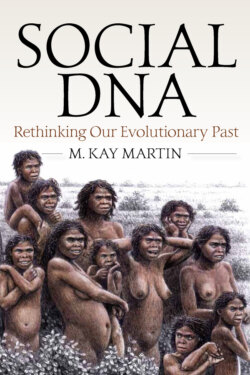Читать книгу Social DNA - M. Kay Martin - Страница 13
На сайте Литреса книга снята с продажи.
False Prototypes
ОглавлениеIf Homo sapiens sapiens were the only primate to survive to modern times, the task of breathing life into ancient fossil remains would be doubly challenging. Our ability to observe the behaviors and social life of contemporary apes and monkeys provides an opportunity to identify traits that may be markers of our common ancestry, and hence perhaps equally shared with proto-human populations. Earliest attempts to utilize observations of primates in the wild as a window to societal origins were commonly based on savanna baboons, not only because they were the most highly studied, but because they were thought to occupy human primordial habitats. Lionel Tiger (1969), for example, envisioned baboon male dominance hierarchies as a genetically based precursor to male bonding requirements of the hunt, activities claimed as pivotal to human evolutionary development on the open savanna.
In the succeeding decades, additional studies have more clearly defined the complexity of baboon social organization, along with that of chimpanzees, bonobos, and a variety of Old and New World monkeys. Such studies have provided new information on primate sexuality, male and female dominance hierarchies, and social networks, along with an appreciation of how such behaviors respond to ecological factors. While patterns common to contemporary nonhuman primates provide valuable insights for reconstructing our ancient past, there are some cautionary notes.
Models based on a single species observed in a single habitat are subject to the whims of the author’s choice, and therefore may lead to false generalizations or conclusions. The same may be said about reliance on modern apes as avatars of our ancient past. It is important to remember that all contemporary nonhuman primates have been forced into marginal habitats that are not representative of Plio-Pleistocene ecological conditions. Some apes, such as gorillas and chimpanzees, have been refugees for millions of years, retreating and adapting to the isolation of shrinking African tropical forests. These and other primate species have also suffered repeated encroachments by Homo sapiens, conditions that may enhance competition for resources and fundamentally alter their behaviors and the structure of their communities.
The same cautionary note applies to models of Paleolithic society, which have historically been based on contemporary hunter-gatherers. Virtually every anthropology text on human cultural evolution portrays the !Kung Bushmen, Hadza, or Australian aborigines as examples of what preagricultural life was like in the Pleistocene. The predominant theory has been that the earliest humans emerged with a dietary reliance on animal flesh and ranged into the open, semi-arid savanna as small, highly mobile hunting bands. The so-called hunting hypothesis grew out of conferences and symposia in the 1960s and its standard-bearer, the patrilocal band, was long memorialized in the anthropological literature as the earliest stage in human cultural evolution.9
One of the cautions of viewing lifeways of contemporary hunter-gatherers as windows to our Paleolithic past is that they are cultures in crisis. Khoisan-speaking groups such as the Bushmen were once dominant in eastern and southern Africa, but have been sequentially displaced from favorable ecological niches for centuries by Nilotic herdsmen, Bantu-speaking horticulturalists, colonial Europeans, and contemporary Africans. Similarly, various aboriginal ethnic groups in Australia were not only displaced from resource-rich coastal areas by Europeans, but decimated by genocide and disease. In both cases, depopulation and forced retreat into increasingly marginal habitats has systematically dismantled indigenous social and economic structures. While such societies can serve as useful models for how humans survive conditions of population loss and resource scarcity, the niches they currently occupy and to which they have been forced to adapt cannot be assumed to have dominated the Pleistocene landscape. These populations, like many nonhuman primate groups, are also refugees. The ethnographic present does not represent the ethnographic past.
A related critique of such prototypes is that the diversity of both contemporary and ancient hunter-gatherer adaptations has been systematically ignored (Martin 1974). Why, might one ask, when searching for historic or prehistoric hunter-gatherer examples that may potentially shed light on how Pleistocene populations lived, are the inhabitants of more resource-rich environments not considered? While climate change and increasing aridity were certainly factors affecting the evolution of our species, the impacts of these changes were unevenly distributed in time and space. Some areas of Africa and Eurasia may indeed have experienced rhythms of aridity that mimicked the challenges of today’s Kalahari and Australian deserts. But there were also vast areas of the Old World that remained well-watered and optimal for occupation by humans and other animals. Opportunistic members of all species followed the geography of these rhythms to their advantage. Those that did not perished. It is interesting to contemplate that if our ancestors were among those who chose to tough it out on the arid plain, our lineage may have ended up as just another in a long line of extinctions. The present book will entertain the notion that the ecological niches early hominins occupied and the adaptive strategies they employed through time were not uniform, but diverse. The Ice Age was a challenge that selected for ingenuity and plasticity, and is what made us who we are.
